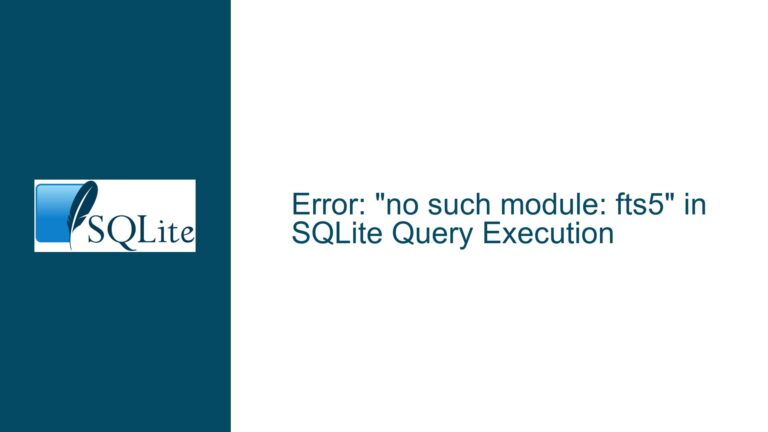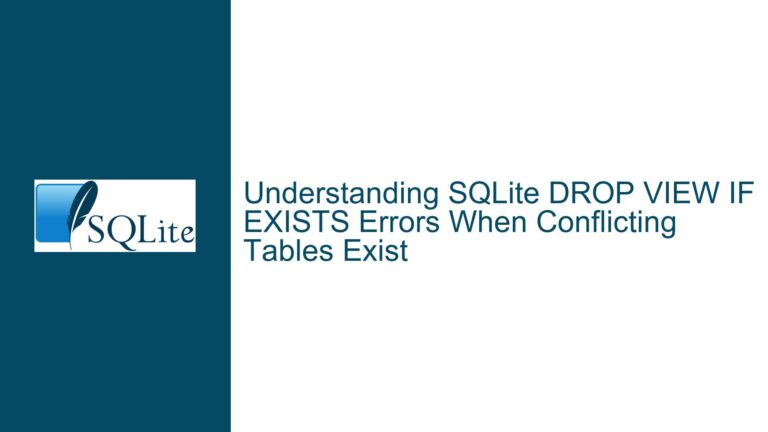Implementing True Multi-Statement Transactions in SQLite
Understanding the Behavior of Multi-Statement Transactions in SQLite
When working with SQLite, one of the most common expectations is that transactions should behave in an "all-or-nothing" manner. This means that if any statement within a transaction fails, the entire transaction should be rolled back, leaving the database in the state it was in before the transaction began. However, as demonstrated in the provided discussion, SQLite’s behavior can sometimes deviate from this expectation, especially when dealing with multi-statement transactions involving constraints like CHECK.
The core issue revolves around the handling of constraint violations within a transaction. Specifically, when a CHECK constraint is violated, SQLite does not automatically roll back the entire transaction. Instead, it continues executing subsequent statements within the transaction, which can lead to partial commits. This behavior is particularly problematic when dealing with multi-table transactions, where the integrity of the data depends on all statements executing successfully.
The Role of Conflict Resolution in Constraint Violations
SQLite provides several conflict resolution strategies, such as ABORT, ROLLBACK, IGNORE, FAIL, and REPLACE. These strategies dictate how SQLite should handle constraint violations. However, the effectiveness of these strategies varies depending on the type of constraint and the context in which it is applied.
In the case of CHECK constraints, the conflict resolution algorithm is always ABORT, regardless of whether ON CONFLICT ROLLBACK is specified. This means that when a CHECK constraint is violated, SQLite will abort the current statement and stop further processing within the transaction. However, it will not automatically roll back the entire transaction. This behavior is by design and is consistent with the SQL standard.
The confusion arises when users expect ON CONFLICT ROLLBACK to apply to CHECK constraints in the same way it applies to UNIQUE or PRIMARY KEY constraints. However, as pointed out in the discussion, ON CONFLICT ROLLBACK does not have the same effect on CHECK constraints. This is because CHECK constraints are evaluated row-by-row, and the conflict resolution algorithm for CHECK constraints is hardcoded to ABORT.
Achieving True Multi-Statement Transaction Rollback
To achieve the desired behavior of rolling back the entire transaction if any statement fails, you need to implement a mechanism that ensures the transaction is rolled back in the event of an error. This can be done using a combination of SQLite’s transaction control statements and error handling in your application code.
One approach is to use the SAVEPOINT feature in SQLite. A SAVEPOINT allows you to create a named point within a transaction to which you can later roll back. If an error occurs, you can roll back to the SAVEPOINT, effectively undoing all changes made since the SAVEPOINT was created. This approach provides a way to implement a true multi-statement transaction rollback.
Here’s how you can use SAVEPOINT to achieve the desired behavior:
BEGIN TRANSACTION;
SAVEPOINT before_inserts;
INSERT INTO job VALUES ('calibrate', 1.5);
INSERT INTO job VALUES ('reset', -0.5);
INSERT INTO job VALUES ('clean', 0.5);
-- Check for errors
SELECT CASE WHEN changes() = 0 THEN RAISE(ROLLBACK, 'Constraint violation') END;
RELEASE before_inserts;
COMMIT;
In this example, if any of the INSERT statements fail due to a CHECK constraint violation, the RAISE function will trigger a rollback to the SAVEPOINT, undoing all changes made within the transaction. This ensures that the database remains in a consistent state.
Handling Multi-Table Transactions
When dealing with multi-table transactions, the same principles apply. You need to ensure that if any statement fails, the entire transaction is rolled back. This can be achieved by using SAVEPOINT and carefully checking for errors after each statement.
Consider the following example, where you want to insert records into two different tables within the same transaction:
BEGIN TRANSACTION;
SAVEPOINT before_inserts;
INSERT INTO job VALUES ('calibrate', 1.5);
INSERT INTO person VALUES ('adrian', 'calibrate');
INSERT INTO job VALUES ('reset', -0.5); -- This will fail
INSERT INTO person VALUES ('greg', 'reset');
-- Check for errors
SELECT CASE WHEN changes() = 0 THEN RAISE(ROLLBACK, 'Constraint violation') END;
RELEASE before_inserts;
COMMIT;
In this example, if the INSERT into the job table fails due to a CHECK constraint violation, the RAISE function will trigger a rollback to the SAVEPOINT, ensuring that no changes are made to either table.
Using Application-Level Error Handling
Another approach to achieving true multi-statement transaction rollback is to handle errors at the application level. This involves executing each statement within the transaction and checking for errors after each execution. If an error is detected, the application can issue a ROLLBACK statement to undo the transaction.
Here’s an example of how this can be implemented in Python using the sqlite3 module:
import sqlite3
def execute_transaction(db_path):
conn = sqlite3.connect(db_path)
cursor = conn.cursor()
try:
cursor.execute("BEGIN TRANSACTION;")
cursor.execute("INSERT INTO job VALUES ('calibrate', 1.5);")
cursor.execute("INSERT INTO person VALUES ('adrian', 'calibrate');")
cursor.execute("INSERT INTO job VALUES ('reset', -0.5);") # This will fail
cursor.execute("INSERT INTO person VALUES ('greg', 'reset');")
conn.commit()
except sqlite3.Error as e:
print(f"An error occurred: {e}")
conn.rollback()
finally:
conn.close()
execute_transaction('example.db')
In this example, if any of the INSERT statements fail, the except block will catch the error, and the ROLLBACK statement will be executed, ensuring that the transaction is rolled back.
Conclusion
Implementing true multi-statement transactions in SQLite requires a clear understanding of how SQLite handles constraint violations and transaction control. While SQLite’s default behavior may not always align with the "all-or-nothing" expectation, you can achieve the desired behavior by using features like SAVEPOINT and application-level error handling.
By carefully structuring your transactions and implementing robust error handling, you can ensure that your database remains in a consistent state, even in the face of constraint violations or other errors. This approach not only aligns with best practices but also provides a reliable foundation for building complex, multi-table transactions in SQLite.






